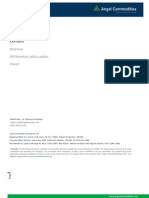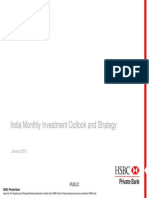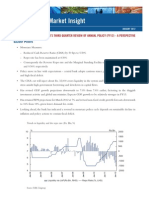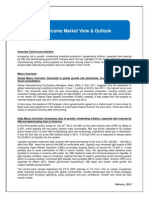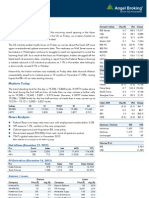Credit Policy 5 Reasons Why RBI Is Unlikely To Act
Credit Policy 5 Reasons Why RBI Is Unlikely To Act
Uploaded by
Shwetabh SrivastavaCopyright:
Available Formats
Credit Policy 5 Reasons Why RBI Is Unlikely To Act
Credit Policy 5 Reasons Why RBI Is Unlikely To Act
Uploaded by
Shwetabh SrivastavaOriginal Title
Copyright
Available Formats
Share this document
Did you find this document useful?
Is this content inappropriate?
Copyright:
Available Formats
Credit Policy 5 Reasons Why RBI Is Unlikely To Act
Credit Policy 5 Reasons Why RBI Is Unlikely To Act
Uploaded by
Shwetabh SrivastavaCopyright:
Available Formats
The Reserve Bank of India will meet for its quarterly monetary policy on Tuesday.
Six weeks ago Governor D Subbarao shocked markets by refusing to cut interest rates. Hardly anyone in the market sees a high probability of a rate cut specially after the RBI made its priorities and concerns clear in the mid quarter review. Since then, little has changed on the macroeconomic front to allow room for a rate cut. Here are five reasons why RBI is not expected to cut rates:
1) FISCAL DISAPPOINTMENT The biggest disappointment for the RBI will continue to be the lack of fiscal action. Despite the RBI's clear message, that further monetary policy action will be linked to signs of credible fiscal consolidation, the government has done nothing. All they have done was to give one political excuse after another for keeping measures on hold. And so, we still await that diesel price hike. The fuel subsidy burden could rise to Rs 1,80,000 crore at $ 105 per barrel oil for the rest of 2012-13. A Rs 5 per litre increase in diesel prices would reduce that by Rs 25,000 crore, according to Kotak Securities estimates. 2) INFLATION RISKS Inflation risks have remained high. The last print on the wholesale price index or WPI and consumer price index or CPI was lower than expected but still remains well above the RBI's comfort level. There has also been a trend of upward revisions in the WPI data, so it would tough to take comfort in the 7.25 per cent read on WPI in June. CPI too remains in double digits. With food prices rising due to a poor monsoon, CPI will likely remain uncomfortable in the months to come. Core inflation is the relatively comfortable indicator. However, RBI has made it clear that they are looking at all indicators of inflation and that one can't call for a rate cut based on the steady core inflation numbers. 3) SLUGGISH GROWTH The growth scenario remains unchanged. Private investment remains on hold. The government has started to make some efforts to revive sector like coal and power but these are measures which will play out in the medium term rather than the short term. This means the investment side of the economy remains weak. The consumption side is where there is still hope. Despite fears of a crack in the domestic consumption, we are yet to see any indicators to show that consumption demand is falling off a cliff. It has moderated, yes. But that was the intention of the RBI so they are unlikely to be fazed by it. 4) GLOBAL FEARS The fourth variable remains global growth. Here, there has been a worsening of conditions.
In response, most central banks, including Asian central banks, have cut rates to support growth. However for India, the domestic macro-economic conditions will and should remain the prime focus. And so, while the RBI may take note of global conditions, it seems difficult to justify a rate cut based on global conditions. 5) LIQUIDITY EASES And then there is liquidity. This is the amount of money supply in the market. Central banks absorb or inject money into the market by buying or selling government securities from banks. These are called open market operations or OMOs. They also use cash reserve ratio or CRR to manage liquidity. CRR is the percentage deposits banks have to maintain with RBI. Liquidity has eased in the past 6 weeks and now is well within the RBI's comfort zone. It is indeed possible, that liquidity pressures will resurface due to the structural sluggishness in the deposit growth. A need to inject money into the system occurs if the credit demand is higher than the deposit growth. But the RBI may not want to pre-empt that with a cut in Cash Reserve Ratio. If liquidity pressures were to re-emerge, they can just as easily restart open market operations or OMOs or cut CRR if and when required late
You might also like
- RBI Monetary Policy UpdateDocument12 pagesRBI Monetary Policy UpdateSai KarthickNo ratings yet
- Week Ended September 21, 2012: Icici Amc Idfc Amc Icici BankDocument4 pagesWeek Ended September 21, 2012: Icici Amc Idfc Amc Icici BankBonthala BadrNo ratings yet
- Macroeconomics Case Analysis On "Trend and Reasons For RBI Credit Policy" byDocument4 pagesMacroeconomics Case Analysis On "Trend and Reasons For RBI Credit Policy" bySandeep SheshamNo ratings yet
- Impt. For AsignmentDocument4 pagesImpt. For AsignmentPranshu_Priyad_8742No ratings yet
- Monetary Policy ReviewDocument4 pagesMonetary Policy ReviewiesmcrcNo ratings yet
- Monetory PolicyDocument21 pagesMonetory Policyharikrishna k sNo ratings yet
- Insights Into Editorial A Strategic Pause On RBI Holding Interest RateDocument4 pagesInsights Into Editorial A Strategic Pause On RBI Holding Interest Raterishabh shahNo ratings yet
- RBI Springs Surprise, Cuts Repo by 50 Bps by Dinesh Unnikrishnan & Anup RoyDocument5 pagesRBI Springs Surprise, Cuts Repo by 50 Bps by Dinesh Unnikrishnan & Anup RoymahaktripuriNo ratings yet
- Playing The Debt MarketDocument1 pagePlaying The Debt MarketChandan PreetNo ratings yet
- Monetary Policy ReviewsDocument6 pagesMonetary Policy ReviewspundirsandeepNo ratings yet
- Financial Express Mumbai 01 August 2012 6Document1 pageFinancial Express Mumbai 01 August 2012 6bhaskardoley30385215No ratings yet
- Slide - 1: 2009. Between March 2010 and October 2011 The Reserve Bank Raised Its Policy RepoDocument3 pagesSlide - 1: 2009. Between March 2010 and October 2011 The Reserve Bank Raised Its Policy RepoGarrima ParakhNo ratings yet
- FY 10 Monetary ReviewDocument4 pagesFY 10 Monetary ReviewVivek SarinNo ratings yet
- Times: Rajan Resists Govt Pressure On RatesDocument1 pageTimes: Rajan Resists Govt Pressure On RatesVibhor AggarwalNo ratings yet
- Assignment 3Document5 pagesAssignment 3SuprityNo ratings yet
- RBI Q3 Monetory PolicyDocument9 pagesRBI Q3 Monetory Policydeepakambulkar8166No ratings yet
- Key Highlights:: Inflationary Pressures Overrides Downside Risks To GrowthDocument6 pagesKey Highlights:: Inflationary Pressures Overrides Downside Risks To Growthsamyak_jain_8No ratings yet
- India RBI AI Apr19Document7 pagesIndia RBI AI Apr19Aman GuptaNo ratings yet
- RBI Monetary Policy UpdateDocument4 pagesRBI Monetary Policy UpdateAngel BrokingNo ratings yet
- Market Review Future Outlook Feb2012-SbiDocument6 pagesMarket Review Future Outlook Feb2012-SbiSaurav MandhotraNo ratings yet
- 21MAYDocument3 pages21MAYritudahiya1389No ratings yet
- RBI S Annual Monetary Policy: RBI Revised Repo Rate and CRR. Policy Expected To Be Aggresive Amid High InflationDocument27 pagesRBI S Annual Monetary Policy: RBI Revised Repo Rate and CRR. Policy Expected To Be Aggresive Amid High Inflationsheetal_sab19929665No ratings yet
- RBI Monetary Policy Review, 17th June 13Document5 pagesRBI Monetary Policy Review, 17th June 13Angel BrokingNo ratings yet
- RBI Sept PolicyDocument1 pageRBI Sept PolicyMohammad FaizanNo ratings yet
- New Repo and Reverse Repo RatesDocument2 pagesNew Repo and Reverse Repo RatesbankportalibpsNo ratings yet
- Policy ET Report For 20241009Document13 pagesPolicy ET Report For 20241009Salman KhanNo ratings yet
- Reserve Bank of India and Its Impact On The Indian Economy Post 1991 (Interest Rates, Exchange Rates and Inflation)Document7 pagesReserve Bank of India and Its Impact On The Indian Economy Post 1991 (Interest Rates, Exchange Rates and Inflation)Mrunal DubeyNo ratings yet
- Monetary PolDocument3 pagesMonetary Polst1dNo ratings yet
- Icici Prudential Mutual Fund Rbi Second Quarter Review of Monetary Policy 2010-11Document4 pagesIcici Prudential Mutual Fund Rbi Second Quarter Review of Monetary Policy 2010-11Vinit KumarNo ratings yet
- Article On Monetary PolicyDocument3 pagesArticle On Monetary PolicyMahi YadavNo ratings yet
- Monetary Policy Note - October 2024Document3 pagesMonetary Policy Note - October 2024abhaykumarmittal001No ratings yet
- RBI's Third Quarter Review-Shift in Monetary Policy 2009-10 Stance-VRK100-29012010Document7 pagesRBI's Third Quarter Review-Shift in Monetary Policy 2009-10 Stance-VRK100-29012010RamaKrishna Vadlamudi, CFANo ratings yet
- India Monthly Investment Outlook and Strategy: January 2013Document13 pagesIndia Monthly Investment Outlook and Strategy: January 2013saikumarmohinderNo ratings yet
- Market Outlook 16th September 2011Document6 pagesMarket Outlook 16th September 2011Angel BrokingNo ratings yet
- Banking Case StudyDocument9 pagesBanking Case Studyainesh_mukherjeeNo ratings yet
- Market Insight Q3FY12 RBI Policy Review Jan12Document3 pagesMarket Insight Q3FY12 RBI Policy Review Jan12poojarajeswariNo ratings yet
- RBI Raised Interest Rates How This Impacts You!Document5 pagesRBI Raised Interest Rates How This Impacts You!Aishwarya ShettyNo ratings yet
- Indian Financials: Tryst With DestinyDocument28 pagesIndian Financials: Tryst With DestinyJohnny HarlowNo ratings yet
- Rbi Credit PolicyDocument8 pagesRbi Credit PolicyamishkanungoNo ratings yet
- Subbarao Puts Onus On Govt: Slash in CRR May Be RBI's Curtain-Raiser To Rate CutsDocument3 pagesSubbarao Puts Onus On Govt: Slash in CRR May Be RBI's Curtain-Raiser To Rate CutsfinscholarNo ratings yet
- RBI Mid Quarter Monetary Policy Review Revised PDFDocument2 pagesRBI Mid Quarter Monetary Policy Review Revised PDFArnab MullickNo ratings yet
- Monetary Policy of India - WikipediaDocument4 pagesMonetary Policy of India - Wikipediaambikesh008No ratings yet
- RBI Hikes Repo Rate For First Time in Four Years by Kapil KathpalDocument31 pagesRBI Hikes Repo Rate For First Time in Four Years by Kapil Kathpal32divyanshuNo ratings yet
- 8th April Monetary PolicyDocument3 pages8th April Monetary PolicyNeeleshNo ratings yet
- RbiDocument6 pagesRbiAnjali RaiNo ratings yet
- LinkDocument24 pagesLinkDhileepan KumarasamyNo ratings yet
- FixedIncome January 2012Document3 pagesFixedIncome January 2012jayaram_mca83No ratings yet
- RBI Monetary Policy - August 17Document3 pagesRBI Monetary Policy - August 17pappuNo ratings yet
- Why RBI Raised Rates How This Impacts You!Document12 pagesWhy RBI Raised Rates How This Impacts You!Avinash2458No ratings yet
- Rbi Monetary PolicyDocument5 pagesRbi Monetary PolicyRohit GuptaNo ratings yet
- Market Outlook Market Outlook: Dealer's DiaryDocument15 pagesMarket Outlook Market Outlook: Dealer's DiaryAngel BrokingNo ratings yet
- RBI Rate Hike A GivenDocument2 pagesRBI Rate Hike A GivenMuana Lal Thla JAfNo ratings yet
- RBI Credit PolicyDocument1 pageRBI Credit Policysangya01No ratings yet
- Assignment of Managerial Economics: Topic:Steps Taken by RBI To Control InflationDocument7 pagesAssignment of Managerial Economics: Topic:Steps Taken by RBI To Control Inflationliyakat_khanNo ratings yet
- Initiating Coverage HDFC Bank - 170212Document14 pagesInitiating Coverage HDFC Bank - 170212Sumit JatiaNo ratings yet
- Chairman Interview Business StandardDocument1 pageChairman Interview Business Standardsushant_shaantNo ratings yet
- SG IndiaDocument6 pagesSG IndiaAjay KastureNo ratings yet
- TATA AIA Annual Report March 2020Document22 pagesTATA AIA Annual Report March 2020SantoshNo ratings yet


















